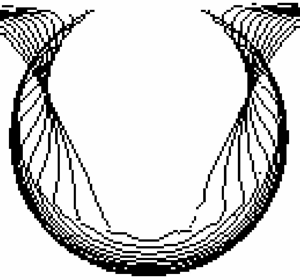Article contents
Dynamics of collapse of free-surface bubbles: effects of gravity and viscosity
Published online by Cambridge University Press: 06 February 2024
Abstract

The rupture of the thin film at the top of a bubble at a liquid–gas interface leads to an axisymmetric collapse of the bubble cavity. We present scaling laws for such a cavity collapse, established from experiments conducted with bubbles spanning a wide range of Bond ( ${10^{-3}< Bo\leq 1}$) and Ohnesorge numbers (
${10^{-3}< Bo\leq 1}$) and Ohnesorge numbers ( ${10^{-3}< Oh<10^{-1}}$), defined with the bubble radius
${10^{-3}< Oh<10^{-1}}$), defined with the bubble radius  $R$. The cavity collapse is a capillary-driven process, with a dependency on viscosity and gravity, affecting respectively, precursory capillary waves on the cavity boundary and the static bubble shape. The collapse is characterised by the normal interface velocity (
$R$. The cavity collapse is a capillary-driven process, with a dependency on viscosity and gravity, affecting respectively, precursory capillary waves on the cavity boundary and the static bubble shape. The collapse is characterised by the normal interface velocity ( $U_n$) and by the tangential wave propagation velocity of the kink (
$U_n$) and by the tangential wave propagation velocity of the kink ( $U_t$), defined by the intersection of the concave cavity boundary formed after the rupture of the thin film with the convex boundary of the bubble cavity. During the collapse,
$U_t$), defined by the intersection of the concave cavity boundary formed after the rupture of the thin film with the convex boundary of the bubble cavity. During the collapse,  $U_t$ remains constant and is shown to be
$U_t$ remains constant and is shown to be  $U_t=4.5U_c{\mathcal {W}}_R$, where
$U_t=4.5U_c{\mathcal {W}}_R$, where  $U_c$ is the capillary velocity and
$U_c$ is the capillary velocity and  ${\mathcal {W}}_R(Oh,Bo)={(1-\sqrt {Oh {\mathscr {L}}} )^{-1/2}}$ is the wave resistance factor due to the precursory capillary waves, with
${\mathcal {W}}_R(Oh,Bo)={(1-\sqrt {Oh {\mathscr {L}}} )^{-1/2}}$ is the wave resistance factor due to the precursory capillary waves, with  $\mathscr {L}(Bo)$ being the path correction of the kink motion. The movement of the kink in the normal direction is part of the inward shrinkage of the whole cavity due to the sudden reduction of gas pressure inside the bubble cavity after the thin film rupture. This normal velocity is shown to scale as
$\mathscr {L}(Bo)$ being the path correction of the kink motion. The movement of the kink in the normal direction is part of the inward shrinkage of the whole cavity due to the sudden reduction of gas pressure inside the bubble cavity after the thin film rupture. This normal velocity is shown to scale as  $U_c$ in the equatorial plane, while at the bottom of the cavity
$U_c$ in the equatorial plane, while at the bottom of the cavity  $\bar {U}_{nb}=U_c(Z_c/R)({\mathcal {W}_R}/ {\mathscr {L}})$, where
$\bar {U}_{nb}=U_c(Z_c/R)({\mathcal {W}_R}/ {\mathscr {L}})$, where  $Z_c(Bo)$ is the static cavity depth. The filling rate of the cavity, which remains a constant throughout the collapse, is shown to be entirely determined by the shrinking velocity and scales as
$Z_c(Bo)$ is the static cavity depth. The filling rate of the cavity, which remains a constant throughout the collapse, is shown to be entirely determined by the shrinking velocity and scales as  ${Q_T\simeq 2{\rm \pi} R Z_c U_c}$. From
${Q_T\simeq 2{\rm \pi} R Z_c U_c}$. From  $Q_T$ we recover the jet velocity scaling, thereby relating the cavity collapse with the jet velocity scaling.
$Q_T$ we recover the jet velocity scaling, thereby relating the cavity collapse with the jet velocity scaling.
Information
- Type
- JFM Papers
- Information
- Copyright
- © The Author(s), 2024. Published by Cambridge University Press
References
Krishnan et al. supplementary movie 1
- 5
- Cited by


